- Home
- Prelims
- Mains
- Current Affairs
- Study Materials
- Test Series
13th Oct 2021
CRITERIA FOR ECONOMICALLY WEAKER SECTIONS (EWS) CATEGORY
A Supreme Court bench has asked the Central Government to file an affidavit explaining the “basis” on which the amount of Rs. 8 Lakh was arrived as a classifying criteria for Economically Weaker Sections (EWS) category.
Highlights:
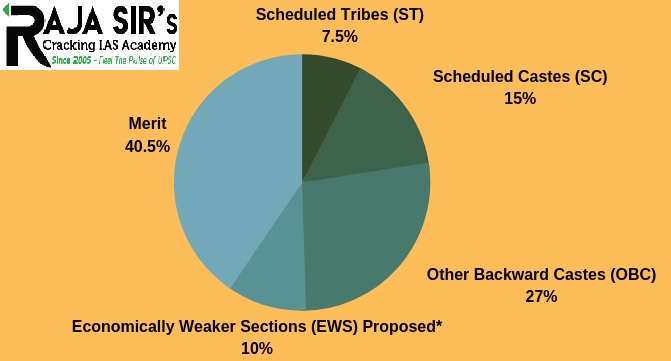
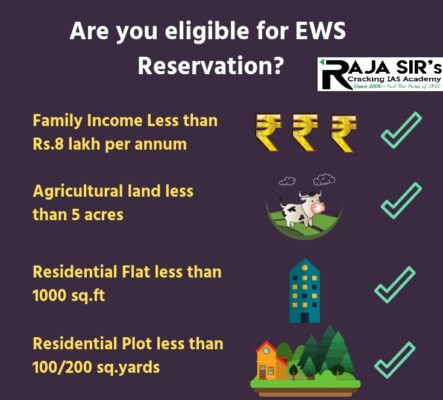


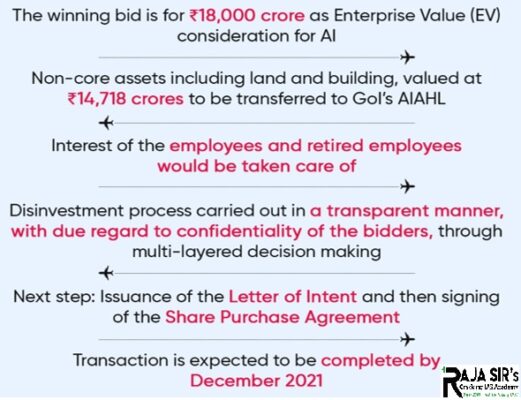
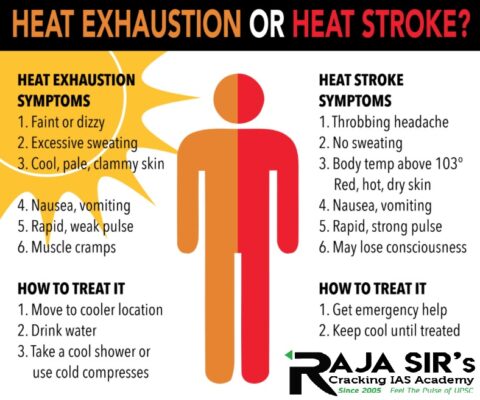



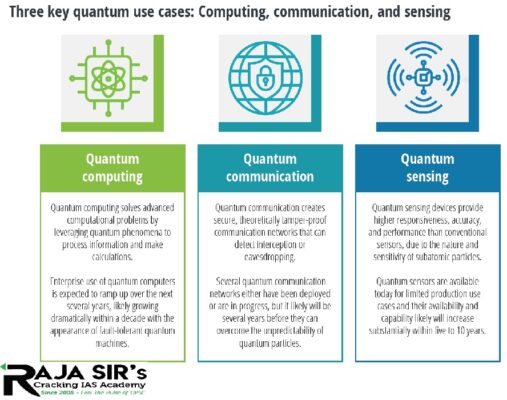

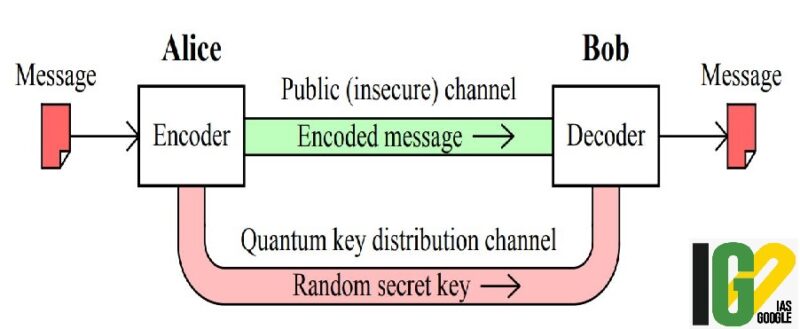
 ‘Trishul’:
‘Trishul’:
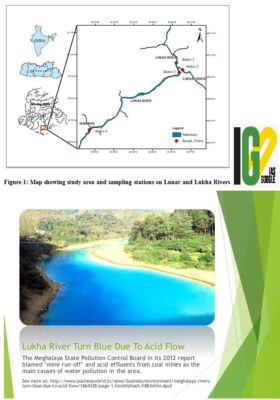

- The court was hearing a batch of petitions filed by NEET aspirants challenging a July 29 notification of the Central Government Centre announcing 27% quota to OBCs and 10% reservation to EWS in the all-India quota category.
- One Hundred and Third Constitutional Amendment of 2019, which introduced the 10% EWS quota, is itself under challenge before a larger Bench.
- The 103rd Constitutional Amendment Act provided for the EWS (for Economically Weaker Sections) 10% quota as an economic reservation (10% quota) in jobs and admissions in education institutes.
- Article 15 and 16 were amended for the same.
- The act enables both Centre and the states to provide reservation to EWS, based on their definition for the same.
- A candidate must not fall under any SC/ST/OBC categories and fulfil the EWS economic criteria are to be part of the EWS category.

- It may be against the Basic Structure of the Constitution:
- Although there are constitutional special protections guaranteed to socially disadvantaged groups, EWS is on an economic basis.
- It violates the 1992 SC judgement in the Indra Sawhney Case, which upheld the Mandal Report and introduced the 50% cap on reservations where the court held that economic backwardness cannot be the sole criterion for backwardness.
- Private, unaided educational institutions cannot be imposed on to implement EWS as it is violative of rights enshrined in Article 19.
- 8 lakh income threshold is very high and will practically covers nearly 85% of the population not already covered by reservations.
- It could highlight the need of equity to balance the stark economic inequality in India.
- This constitutionally recognises the inclusion of urban and rural poor in the backward categories that need upliftment.
- The move puts down the social stigma of reservation associated by lower castes.
- The technology is developed by Council of Scientific and Industrial Research-National Geophysical Research Institute (CSIR-NGRI), Hyderabad.

- Aim: Mapping potential groundwater sources and its management for providing safe drinking water to millions of people living in the water scarce arid regions of our country.
- The mega project of Rs. 150 crores will be implemented in two phases in collaboration with the Ministry of Jal Shakti as a part of National Aquifer Mapping Project.
- The Heli-borne geophysical mapping technique provides a high-resolution 3D image of the sub-surface up to a depth of 500 meters below the ground.
- Aquifer Mapping & Management in Arid Regions will supplement the goals of “Har Ghar Nal Se Jal” scheme, as well as doubling farmers income.
- The technology will provide ground water solutions in the arid and semi-arid regions of North-western India.
- Rajasthan
- Gujarat
- Punjab
- Haryana
- Arid areas in north western India cover nearly 12% of the total geographical area of the country with home to more than 8 crore people.
- With an annual rainfall of less than 100 to 400 mm, the area in the four states mentioned, faces an acute shortage of water throughout the year.
- The scheme is proposed to take up high-resolution aquifer mapping and management to augment the groundwater resources.
- Admitting that the present unit cost of vessel for deep sea fishing under the Palk Bay Scheme (PBS) of Rs. 80 Lakhs is inadequate, the Union government is considering to boost the unit cost to approximately Rs. 1.3 Cr per unit.

- Known as Tuna Long lining and gillnetting fishing vessels, the boats are equipped with:
- Modern navigation and communication equipment
- Advanced net hauling and liner winches
- Galleys
- Bio- toilets
- Refrigerated seawater systems
- Stainless steel-cladded PUF (Polyurethane Foam) insulated Fish Hold to preserve the catch.
- Launched by the Prime Minister in July 2017, the scheme comes under the wider umbrella of Blue Revolution Scheme.
- In efforts to promote fishing as an allied activity, Government of India launched the Blue Revolution Scheme with an aim to double the income of fishermen.
- PBS is a Tamil Nadu specific scheme aimed at providing 2000 deep sea fishing vessels within a span of 3 years.
- Funding pattern:
- 50% by Central Government
- 20% by State Government
- 10% by the beneficiary
- 20% by institutional funding like banks.
- To replace all trawler boats and introduce over 2,000 deep sea fishing boats in a period of five years.
- To promote fishermen to take up deep-sea fishing and put an end to disputes arising between the India and Sri Lanka due to bottom trawling.
- Bottom trawling equipment drag weighted nets along the deep sea-floor, causing irreversible depletion of aquatic resources and is ecologically catastrophic.
- To diversify fishing waters into the Indian Ocean, Arabian sea and other deep-sea areas to look for fish like tuna that are in high demand.
- To reduce fisherman faceoff along the International Maritime Border Line with Sri Lanka.
- Fishing is permitted on country craft boats within 5 nautical miles (nm) and on mechanised vessels between 5 and 12 nm.
- Over the years, fishermen on country craft boats and mechanised vessels have moved far beyond the 12 nm mark, as the availability of fish reduced in the terrestrial sea.
- The State government has control up to 12 nm from the base line, while the rest is vested with the Union government.
- Only grant licenses to vessels registered under the Merchant Shipping Act, 1958, to fish in the EEZ.
- Put the Indian Coast Guard (ICG) in charge of Monitoring Control and Surveillance (MCS).
- Punish the fishermen breaching the EEZ without a licence, not complying with ICG orders, and obstructing ICG officials.
- Fishermen primarily depend on the continental shelf area and the EEZ because of the availability of fish in the terrestrial sea is shrinking.
- There has been a drastic decline in fishing resources in the Indian ocean, attributing it to destructive fishing practice by trawlers, climatic changes, the continental plate drift during the 2004 tsunami, and excess fishing by international long liners in the EEZ.
- The prospects of Conch collecting fisherman will be destroyed by the Bill as they collect conches beyond 12 nm.
- Traditional fishing includes conch collection from the seabed. Several hundreds of fishermen depend on conch diving.
- It is alleged that the Bill is against the interests of traditional fishermen, who contribute several crore rupees to the Gross Domestic Product, and should be withdrawn as it was not drafted in consultation with traditional fishermen along the coast.
- Territorial zone - 12 nautical miles (nm) from shore baseline
- Contiguous zone - 12 nm from end of territorial zone
- Exclusive Economic Zone (EEZ) - 200 nm from end of territorial zone
- High seas - from end of the Exclusive Economic Zone.
- The Atlas is issued every three years and is a compilation of data provided by countries around the world on mental health policies, legislation, financing, human resources, availability and utilization of services and data collection systems.
- It is also the mechanism for monitoring progress towards meeting the targets in WHO’s Comprehensive Mental Health Action Plan.
- Increased attention given to mental health in recent years has yet to result in a scale-up of quality mental services that is aligned with needs.
- None of the targets for effective leadership and governance for mental health, provision of mental health services in community-based settings, mental health promotion and prevention, and strengthening of information systems, were close to being achieved.
- In 2020, just 51 per cent of WHO’s 194 member states reported that their mental health policy or plan was in line with international and regional human rights instruments, way short of the 80% target.
- Only 52 per cent of countries met the target relating to mental health promotion and prevention programmes, also well below the 80 per cent target.
- The only 2020 target met was a reduction in the rate of suicide by 10 per cent, but even then, only 35 countries said they had a stand-alone prevention strategy, policy or plan.
- Steady progress was evident in the adoption of mental health policies, plans and laws, as well as in improvements in the capacity to report on a set of core mental health indicators.
- However, the percentage of government health budgets spent on mental health has still hovering around 2 per cent.
- Just 39 per cent of responding countries indicated that the necessary human resources had been allocated and 34 per cent that the required financial resources had been provided.
- Only 25 per cent of responding countries met all the criteria for integration of mental health into primary care.
- Systematic decentralization of mental health care to community settings has long been recommended by WHO.
- While progress has been made in training and supervision in most countries, the supply of medicines for mental health conditions and psychosocial care in primary health-care services remains limited.
- This indicates that centralized mental hospitals and institutional inpatient care still receive more funds than services provided in general hospitals and primary health-care centres in many countries.
- More than 70 per cent of total government expenditure on mental health was allocated to mental hospitals in middle-income countries, compared with 35 per cent in high-income countries.
- There was an increase in the percentage of countries reporting that treatment of people with specific mental health conditions (psychosis, bipolar disorder and depression) is included in national health insurance or reimbursement schemes from 73% in 2017 to 80% (or 55% of member states) in 2020.
- Global estimates of people receiving care for specific mental health conditions remained less than 50 per cent, with a global median of 40 per cent of people with depression and just 29 per cent of people with psychosis receiving care.
- Increase in countries reporting mental health promotion and prevention programmes, from 41 per cent of Member States in 2014 to 52 per cent in 2020.
- However, 31 per cent of total reported programmes did not have dedicated human and financial resources, 27% did not have a defined plan, and 39 per cent had no documented evidence of progress and/or impact.
- Global targets reported in the Mental Health Atlas are from WHO’s Comprehensive Mental Health Action Plan, which contained targets for 2020 has now been extended to 2030.
- It includes new targets for the inclusion of mental health and psychosocial support in emergency preparedness plans, the integration of mental health into primary health care, and research on mental health.
- The World Health Organisation recognises World Mental Health Day on 10 October every year.
- Objective: To raise awareness of mental health issues around the world and to mobilize efforts in support of mental health.
- The Day provides an opportunity for all stakeholders working on mental health issues to talk about their work, and what more needs to be done to make mental health care a reality for people worldwide.
- Theme for 2021: 'Mental health in an unequal world'.
- The government will offload 100% of its stake in Air India, compared with 76% put on the block last time.

- Air India was started by the Tata Group in 1932.
- After independence the Central Government bought 49% stake in AI.
- In 1953, the government bought the remaining stake, and AI was nationalized.
- End of Monopoly
- With economic liberalisation and the growing presence of private players, the dominance came under serious threat.
- Authority Under Government
- The government running an airline did not quite gel with the mantra of liberalisation.
- Continuous Loss
- By 2007, AI was merged with the domestic carrier, Indian Airlines, to reduce losses.
- But it has never made a profit since 2007.
- As of August 2021, AI’s debt was Rs 61,562 crore. Every additional day that AI remains operational, the government suffers a loss of Rs 7,300 crore annually.
- Amalgamation
- The merger between Air India and Indian Airlines in 2006-07, has remained only on paper. The resources, aircraft, men, material, and machines remained divided.
- The merger without employee led to problems like excess manpower.
- Poor Maharajah but rich Employees
- Air India paid a heavy price for “buying peace” with unions during mid-1990s.
- Paying huge salaries to its pilots and aircraft maintenance engineers hit the airline hard.
- The first attempt to reduce the government’s stake; disinvestment was made in 2001.
- The attempt to sell 40% stake failed. As the viability of running AI worsened with every passing year.
- In 2018, government made another attempt to sell the stake with 76%. But it did not elicit even a response from the bidders.
- The latest attempt was initiated in January 2020; hence the government has been able to conclude the sale.
- The government kept a certain shareholding of AI, hence private players did not seem interested.
- As the private firms wonder, if they would have the operational freedom to turn around a loss-making airline.
- Earlier, the government expected the bidders to pick up certain amount of the debt along with the airline, this approach did not work.
- This time, the government let the bidders decide the amount of debt they wanted to pick up.
- It underscores government’s commitment to reducing the government’s role in the economy.
- It will save the taxpayers paying for the daily losses of AI.
- From the Tatas’ perspective, AI’s acquisition is a long-term deal.
- They will invest more assets than what they have paid the government, if this deal goes in favour for them.
- Punjab is producing over 20 million tonnes of paddy straw every year, most of which is burnt in fields by farmers, leading to widespread air pollution that even spreads to neighbouring states.
- Nearly 30.4 per cent of rice straw is used for animal feed in Southeast Asia, Mongolia and China.
- In Punjab, the total availability of paddy straw is about 20 million tones per annum.
- The total value of this straw is Rs 400 crore approx., calculated on an average rate of Rs 200/quintal.
- If all of it is burnt in fields, it accounts for economic loss apart from the loss of 77,000 tonnes of nitrogen and 5.6 million tonnes of Total Digestible Nutrients (TDN) which could be used for ruminant production.
- Nutritional value: 10 lakh tonnes of crude protein (CP), 3 lakh tonnes of digestible crude protein (DCP), 80 lakh tonnes of total digestible nutrients (TDN) and phosphorous.
- High silica and lignin content reduces its digestive properties. Higher selenium content in paddy straw also limits its use as fodder in animals as compared to wheat straw.
- However, if given in moderate quantities (up to 5 kg per animal per day), selenium poses no health hazard to the animal.
- Paddy straw also contains oxalates (2-2.5%) which leads to calcium deficiency. So mineral mixture should always be fed along with the straw.
- Urea-only treatment:
- The paddy straw is chaffed and moistened (physical) with urea solution (chemical), the breakdown of urea release ammonia gas, a part of which is utilised by microbes (biological) for their proliferation (enriching the straw with microbial protein), resulting in rise of stack temperature, which facilitates the penetration of ammonia in the cell wall, resulting in breakage of lingo-cellulosic bonds making cellulose and hemi-cellulose assessable for utilization by microbes in the rumen.
- The digestibility of cellulose increases from 40-45% in untreated paddy straw to 70-75 per cent in fermented wheat straw.
- Urea plus molasses treatment
- Also called “Urea-Molasses impregnated straw”.
- It involves treating paddy straw with urea and molasses. Urea and molasses mixed with water. Then it is mixed with chaffed paddy straw and fed to animals on same day.
- This treated straw along with mineral mixture and salt makes up a maintenance ration for non-producing animals.
- However, maintenance of body weight in animals, paddy straw alone is not sufficient. Minerals and green fodder supplementation are required.
- Silica: Intake of siliceous forages has been associated with urinary siliceous calculi in drier regions where water may be limited.
- It commonly formed in sheep and cattle.
- Oxalates are broken down in the rumen to carbonates and bicarbonates, absorbed, and then excreted in the urine. The pH of water extracts of rice straw is about 8 and that of urine from stock-fed rice straw as high as 9.
- The high oxalate content has been implicated in the greater need for calcium supplementation.
- High selenium (0.5 to 4.5 %) content which can cause a serious health problem in dairy animals.
- The study has looked at temperature data of pre-monsoon (March-May) and early summer monsoon (June-July) seasons from the India Meteorological Department, spanning 65 years from 1951-2016.
- It studied the monthly, seasonal, decadal and long-term trends in heatwaves in the country.

- It has found a warming pattern over north-western and southern India, while a progressive cooling phase over northeastern and southwest regions of the country.
- A “spatio-temporal shift” in the occurrence of heatwave events, with a significantly increasing trend in three prominent heat wave prone regions was observed.
- North-western, central, and south-central India, with the highest being in west Madhya Pradesh (0.80 events/year).
- Heatwaves have been traditionally associated with UP, Bihar, Delhi and northern parts of Madhya Pradesh.
- Both heatwaves and severe heatwaves are increasing and also new locations were found where these events are taking place, especially in the last two decades.
- Heatwaves have found in southern Madhya Pradesh, Andhra Pradesh, Karnataka and Tamil Nadu, where they would traditionally not take place.
- An increase in heatwaves in Karnataka and Tamil Nadu are particularly significant, and point to increased events in the future.
- A significant decrease was found in heatwaves over the eastern region, that is Gangetic West Bengal (−0.13events/year).
- Over the past few decades, heatwaves have emerged in southern states which had previously not experienced such events.
- Especially severe heatwave events have shown a “southward expansion and a spatial surge during the decades of 2001–2010 and 2010–2016”.
- During the period 1961–2010, from March-July, the highest number of heatwave days were experienced over the northwestern, northern, central, and eastern coastal regions, with an average of eight heatwave days and 1-3 severe heatwave days during the season.
- Two elements that have exacerbated the heatwave conditions in the country:
- Increase in night time temperatures, which disallows heat discharge at night, and
- Increasing humidity levels.
- An increasing trend of heatwave days and severe heatwave days was observed in the decade of 2001–2010 as compared to previous decades.
- The eastern and western coasts, which are currently unaffected by heatwaves, will be severely impacted in the future.
- A jump in heat-related deaths, from 5330 deaths reported during 1978–1999 to extreme cases of 3054 and 2248 deaths in 2003 and 2015, respectively.
- Heatwaves are defined as prolonged episodes of extreme temperature over any region.
- Apart from temperature, humidity is an important parameter considered for declaring heat-related stress.
- To be considered a heat wave, the temperatures have to be outside the historical averages for a given area.
- Qualitatively, heat wave is a condition of air temperature which becomes fatal to human body when exposed.
- For India, heat wave is considered if maximum temperature of a station reaches at least 40OC or more for Plains and at least 30OC or more for Hilly regions.
- Based on Departure from Normal:
- Heat Wave: Departure from normal is 4.50C to 6.40C
- Severe Heat Wave: Departure from normal is >6.40C
- According to OECD, of the 140 countries engaged in the negotiations, 136 signed on to the new outline, who together accounted for over 90% of the global economy.
- Four countries had not yet joined the agreement. These are- Kenya, Nigeria, Pakistan, and Sri Lanka.

- A global minimum corporate tax rate is a proposal to reduce tax competition between countries and the avoidance of corporate taxes by setting a world-wide minimum corporate tax rate.
- Aim: To put an end to decades of tax competition between governments to attract foreign investment.
- With budgets strained after the COVID-19 crisis, many governments want to discourage multinationals from shifting profits and tax revenues.
- In order to low-tax countries regardless of their sales.
- Rising income from intangible sources like drug patents, software, and royalties on intellectual property, allowed companies to avoid paying higher taxes in their home countries.
- To ensure a fairer distribution of profits and taxing rights among countries including the largest MNEs, with digital companies.
- It would re-allocate some taxing rights over MNEs from their home countries to the markets where they have earned profits.
- Taxing rights on more than USD 100 billion of profit will be reallocated to market jurisdictions every year.
- It seeks to put a floor on competition over corporate income tax, through global minimum tax rate that countries can use to protect their tax bases.

- It will provide support to governments, to raise necessary revenues for their budget and balance sheet while investing in public services, and infrastructure.
- It will optimize the strength and the quality of the post-COVID recovery.
- As per OECD, the minimum tax will generate $150 billion in additional global tax revenues annually.
- Taxing rights on more than $125 billion of profit will be shifted to the countries where they have earned from the low tax countries.
- The deal will encourage multinationals to repatriate capital to their country, giving a boost to the economy.
- The Norwegian Nobel Committee awarded the peace prize for defending the freedom of expression.
- The committee expressed that Free, Independent and Fact-based journalism serves to protect against abuse of power, lies and war propaganda, which is instrumental in promoting peace.

- Muratov has been a founding member of one of the most the independent Russian newspapers Novaya Gazeta since and has a fundamentally critical attitude towards power.
- Ms Ressa in 2012 co-founded Rappler, a news website which documented how social media is being used to spread fake news, harass opponents and manipulate public discourse.
- Both of their works have been recognized for fact-based journalism and professional integrity.
- All Nobel Prizes are awarded in Stockholm, Sweden, except for the Nobel Peace Prize, which is awarded in Oslo, Norway.
- The founder of the Nobel Prize, Alfred Nobel, was a Swedish cosmopolitan.
- In his will, he declared that the Nobel Peace Prize should be awarded by a Norwegian committee.
- According to statutes of the Nobel Foundation:
- Prize cannot be awarded to more than 3 persons.
- If prize is given to separate works, the prize money has to be divided equally.
- After 1974, a prize cannot be awarded posthumously, unless death has occurred after the announcement of the Nobel Prize.
- Youngest Nobel Peace Prize laureate is Malala Yousafzai, who was 17 years old when awarded the 2014 peace prize.
- Mahatma Gandhi, was nominated in 1937, 1938, 1939, 1947 and in 1948 for Nobel prize, but was not awarded the prize.
- The Article 19(1) is a Fundamental Right of the Indian Constitution which guarantees the citizens the right to freedom in certain areas. It guarantees all and only the citizens of India their freedom to speech and expression.
- Article 19(1) provides citizens with the following rights:
- Freedom of speech and expression
- Freedom to assemble peaceably and without arms
- Freedom to form associations or unions
- Freedom to move freely throughout the territory of India
- Freedom to reside and settle in any part of the territory of India
- Freedom to practice any profession, or to carry on any occupation, trade or business.
- Freedom of Speech and Expression is not an absolute right.
- Restrictions were placed on it following Romesh Thapar v. State of Madras (1950) judgement, by the First Amendment Bill 1951.
- The exercise of this right is subject to the following:
- Security, Sovereignty and integrity of the state
- International relations
- Public Order, Defamation, Incitement of offence or immoral display
- Suspension of rights under Article 19 when emergency is proclaimed under Article 352.
- Freedom of Press is not explicitly mentioned in the constitution, but in the landmark case of Maneka Gandhi vs Union of India, Supreme Court has stated that the Freedom of Expression is inclusive of Freedom of Press.
- With the development of QKD solution and the existing suite of wide range of products in Optical Access, Core, Switching & Routing, Wireless, Post Quantum Cryptography Encryptors (PQCE) etc, C-DOT has become the first organization in India to offer complete portfolio of indigenous Quantum Secure telecom products & solutions to comprehensively address the requirements of Telecom Service Providers as well as Strategic and Defense sector in India.

- Quantum technology is a class of technology that works by using the principles of quantum mechanics (the physics of sub-atomic particles), including quantum entanglement and quantum superposition.
- The area has immense potential, impact of which can be compared with that of semiconductor technology in the last few decades or the impact that the laser had since its invention in 1960s.
- Quantum Technologies can broadly be divided into four verticals viz. Quantum Computing, Quantum Communications, Quantum Sensors and Quantum Materials.
- Quantum Technologies are based upon phenomena exhibited by microscopic particles (like photons, electrons, atoms etc.) which are quite distinct from the way normal macroscopic objects behave.
- Behaviour of these microscopic particles can’t be described by Classical (or Conventional) Physics based on Newtonian Mechanics, and consequently Quantum Mechanics came into picture, around 100 years back, to formulate theory to describe such behaviour.
- Quantum Mechanics is probabilistic in contrast to Classical Mechanics which is deterministic.
- Quantum Mechanics is counterintuitive as the phenomena of Superposition, Entanglement, Teleportation & Tunnelling etc. exhibited by microscopic particles appears weird and have no equivalence in everyday life.
- One of the most quoted such phenomena is the “Photoelectric effect” for which Einstein was awarded the Noble Prize in Physics in the Year 1921.
- Applications: exponential increase in computing power, inherently secure communication (teleportation of information), interaction free measurements, extremely precise & sensitive sensors etc.
- India has launched National Mission on Quantum Technologies & Applications (NM-QTA) in February 2020.
- Centre for Development of Telematics (C-DOT), a premier telecom research & development organization is leading the effort in the Quantum Communications vertical of NM-QTA.

- Quantum key distribution (QKD) is a secure communication method for exchanging encryption keys only known between shared parties.
- The communication method uses properties found in quantum physics to exchange cryptographic keys in such a way that is provable and guarantees security.
- QKD enables two parties to produce and share a key that is then used to encrypt and decrypt messages. Specifically, QKD is the method of distributing the key - not the key itself or the messages it can enable users to send.
- QKD works on a scale much different from conventional key distribution in that QKD uses a quantum system that relies on basic and fundamental laws of nature to protect the data, rather than relying on mathematics.
- It can support a distance of more than 100 kilometers on standard optical fiber.
- It addresses the threat that rapid advancement in Quantum Computing poses to the security of the data being transported by various critical sectors through the current communication networks.

- QKD works by transmitting millions of polarized light particles (photons) over a fiber optic cable from one entity to another. Each photon has a random quantum state, and collectively all the photons create a bit stream of ones and zeros.
- When the photons arrive at the endpoint, the receiver uses beam splitters (horizontal/vertical and diagonal) to “read” the polarization of each photon.
- The receiver does not know which beam splitter to use for each photon and has to guess which one to use.
- After the receiver tells the sender which beam splitter was used for each of the photons in the sequence they were sent, the sender then compares that information with the sequence of polarizers used to send the photons.
- The photons that were read using the wrong beam splitter are discarded, and the resulting sequence of bits becomes a unique optical key that can be used to encrypt data.
 ‘Trishul’:
‘Trishul’:
- Trishul is SCR’s first long haul comprising of three freight trains, i.e., 177 wagons.
- This train was started on 7th October from Kondapalli station of Vijayawada division to Khurda division of East Coast Railway.
- Garuda was started from Raichur of Guntakal division to Manuguru of Secunderabad division.
- Long haul trains, which are twice or multiple times longer than the normal composition of freight trains, provide a very effective solution to the problem of capacity constraints in critical sections.
- Both the long haul trains comprised of empty open wagons for loading of coal meant for predominantly thermal power stations.
- The Initiative was launched to curb crime against women, implemented on July 10, 2021.’’
- This initiative was named as "TEJASWINI: Women Centric Safety & Empowerment Initiative' of North-West District".
- Under the initiative, 46 Women Beat Constables were deployed in crime-infested and sensitive areas of various police stations, including JJ clusters of Jahangirpuri, Shakarpur and Pitampura residential areas.
- Aim: To reach out to women belonging to all strata of society and female senior citizens and also to safeguard the rights and dignity of women and children in North-west district.
- To create a conducive atmosphere where women feel at home while interacting with women constables and share their issues and concerns.

- The Lukha river is in the East Jaintia Hills district where most of Meghalaya’s coal mines are located.
- The project was initiated under District Mineral Fund over the contamination of the Lukha, marked by dead fish and the colour of the water turning either blue or yellow.
- The detoxification process is called phycoremediation.
- It has rejuvenated Lukha by using algae to remove toxic contents from the water.
- It has improved the pH level of a critical stretch of the river.
- The function was organised by Sustainable Development Foundation (a unit of EK KAAM DESH KE NAAM) and the awards were presented in the 10th conference held at Dehradun.
- NMDC was rewarded on its contribution towards implementation of Sustainable Development Goals and Environment Management initiatives at its production projects.
- EKDKN’s “Sustainable Development Foundation” is Prestigious "Exceed Award on Environment, CSR and HR Award 2021" scheduled on 8th October 2021 at Dehradun.
- An award is given to an organization to recognize their excellence in a certain field.
- It gives a positive impact on overall Organization and brings new business opportunities.
- It helps the employees to remain committed in giving their best, it drives them to work hard.
- The talent and abilities are acknowledged and awarded; it gives the employees a reason to remain in the company for longer.
- Awards and Recognitions serve as a vehicle for promotion of business through public relation activities and marketing.
- It will benefit for getting support from statutory compliances.
- It gives brand image.
- Getting awards helps the company to get sanction for the govt projects.
- All Large, Medium, Small & Micro Scale Industries, Companies/ Organization / Units / Sub-Units / Factories and Projects are eligible for participation in this Award.









 Latest News
Latest News
 General Studies
General Studies